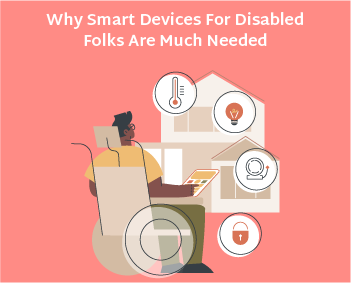We live in a world where technology is essential for everyday life. And as more and more devices become available, it can be difficult to find one that will work for everyone’s needs. But what if you’re disabled??
It’s not easy finding the right device when you don’t know what your specific disability is or where to start looking. This blog post will give you some helpful tips on finding the best smart devices for disabled folks.
The first step is figuring out which type of disabilities you have and then identifying the needed functionalities. There are many different types of disabilities: visual, auditory, physical mobility, speech recognition/production, cognitive processing speed/visual scanning, etc. Once it is identified, it becomes easier to find suitable assistive devices.

Why Smart Devices for Disabled are Important?
Imagine being able to control your home from the comfort of one room. You can dim downlights or turn on a fan without having to walk across an entire house, all with just a few clicks.
That’s what makes smart devices so great; not only do they make life easier by taking away some tasks that are often overlooked (like temperature regulation), but these innovations empower people who live disabled lifestyles because now there is no need for external help in maintaining personal independence and dignity – you’re doing everything yourself via technology.
Benefits
1. Smart devices are the future of home automation. They integrate with various voice assistants, enabling you to control other devices in your house just by giving commands.??
This is great for people who have visual impairments or limited mobility because it eliminates their need to take up physical space on surfaces like thermostats and lights; instead, they can simply speak into an app-enabled device at any time during the day – making them hands-free again.
2. Smart thermostats are a great way to keep your home at just the right temperature no matter where you happen to be. With one touch on their smartphones, they can turn down or up any setting as needed- saving energy while keeping things comfortable.
3. Some curtains and blinds are inconvenient for people with physical disabilities or visual impairments. Smart designs can make it possible to operate them remotely through your smartphone, saving you the hassle of manually operating them yourself.
4. Smart lighting devices are an exciting innovation that can be controlled remotely, turn lights on or off with motion sensors, and connect your house via Wi-Fi. The energy efficiency of these systems is just one advantage they offer to disabled people.?
5. The convenience of having your home controlled from afar is one reason why more people are installing smart devices for disabled. These gadgets can be used to turn on lights or open doors remotely, making life easier for everyone in the house.
6. If you’re struggling with dementia or Alzheimer’s, smart locks can be a lifesaver! They allow caregivers quick access points for emergency services.
7. People who are disabled and living alone should invest in smart security systems because they offer a sense of safety for everyone.?
For example, watch alarms can help visually impaired people know when someone is coming up toward them so that it’s easy to scram away from whatever threat may be approaching instead.
8. Smart homes are the perfect solution for disabled people with their everyday tasks but can’t depend on others. The smart home system offers complete control from anywhere in your house through an app, giving users peace of mind knowing there’s nothing they shouldn?t accomplish without outside help.
How has technology changed the life of the disabled?
The latest gadgets are changing the world. With mobile phones and internet access available even in poor countries, we can be blushing with technology-changing innovation everywhere around us.
For some people, though, new tech brings about profound changes that alter their lives for better or worse–it all depends on how you use your devices. The world is changing, and we are all adapting.
Technology has been a major player in this change, as new technologies give people with disabilities access to the same things everyone else enjoys–like speaking on Skype or reading an article online instead of being limited by what they can accomplish face to face from their home environment alone.
But there’s also something special about how these tech innovations empower those who were previously unable: They allow them enhanced independence that could not have happened before now, providing alternatives for living life fully even when it seems impossible at times.
Innovations like voice recognition software will soon make conversations easier than ever through speech synthesis systems such as Alexa Skills.
Smart Devices for Disabled: A Hope!
Smart devices are the key to a new generation of independence for people living with disabilities.
Not only do they give these individuals freedom and control over their own lives, but smart-device specific apps can also be used in tandem by all kinds of different service providers who want to help make life more manageable – from healthcare professionals offering emergency response systems or diabetes management tools; personal assistants assisting those suffering complications related injury such as Alzheimer?s disease symptoms early onset Progressive Supranuclear Palsy Parkinson’s Disease, etc.
The expansion and growth in the tech industry have given rise to a new era of smart innovation for disabled users. There?s only a need to build greater awareness on this topic and encourage wider adoption so people can lead more fulfilling lives through increased control over their surroundings.

As the editor of the blog, She curate insightful content that sparks curiosity and fosters learning. With a passion for storytelling and a keen eye for detail, she strive to bring diverse perspectives and engaging narratives to readers, ensuring every piece informs, inspires, and enriches.









